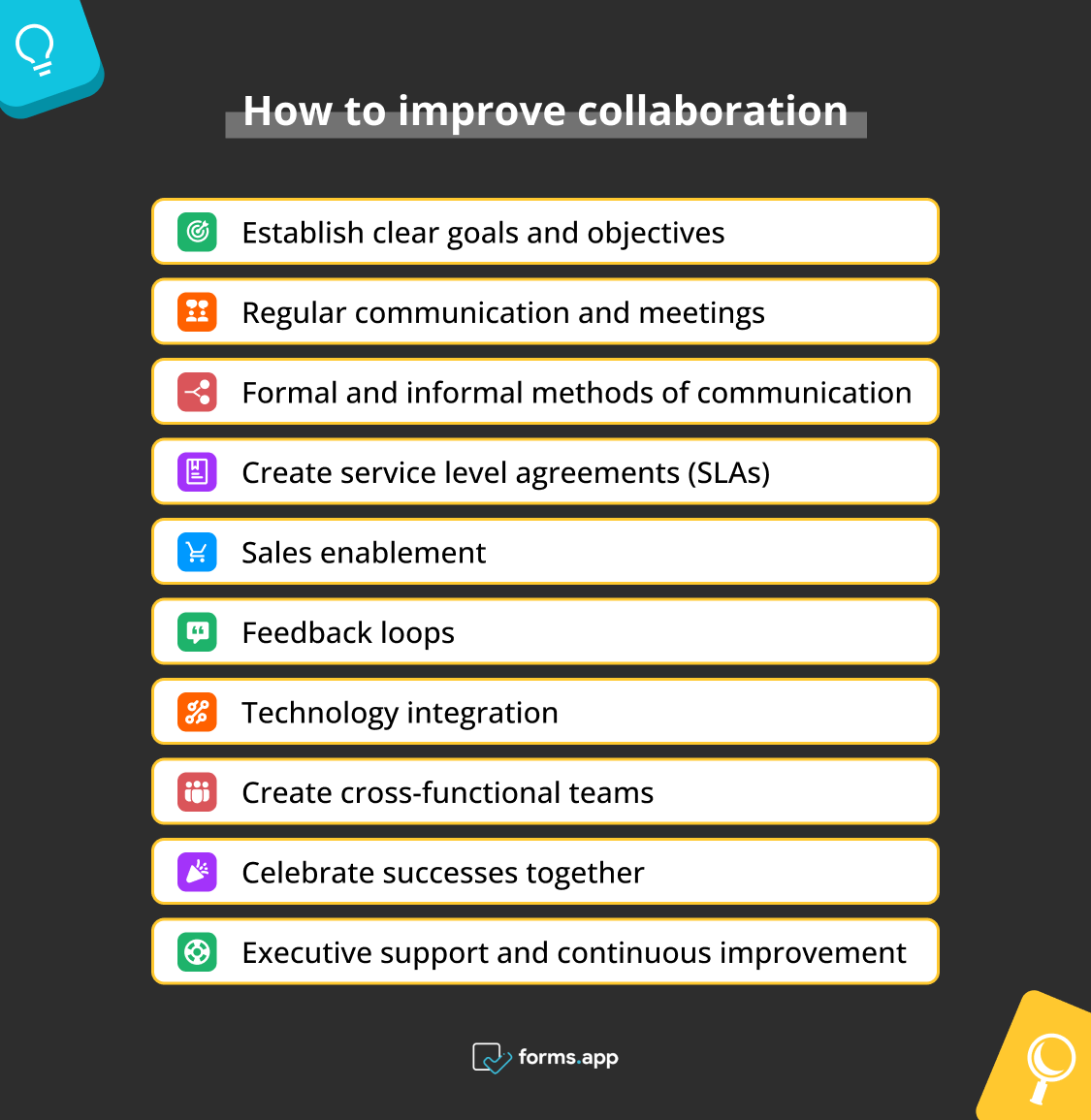In the dynamic world of business, where every decision can be the difference between soaring gains and stunning losses, the community between deals and marketing brigades isn't just an asset; it's a critical lifeline.
Yet, despite this clear advantage, numerous associations still struggle to bridge the gap between these two hustler brigades. Silos, miscommunication, and clashing objects frequently hamper the eventuality of their collaborative success.
But what if this peak could be turned into an unequaled occasion for growth and invention?
In this composition, we will unveil 10 collaboration tips for deals and marketing that promise not just to mend but also to fortify the bond between your deals and marketing platoon.
How to improve collaboration
Enhancing collaboration between sales and marketing teams is pivotal for driving business growth and customer satisfaction. Building an open line of communication is the key. Here are the ten effective strategies to foster a seamless and productive partnership between these key departments:

10 ways to promote collaboration
1. Establish clear goals and objectives
Establishing clear goals and objectives is the cornerstone of effective collaboration between sales and marketing teams. It ensures that both teams are aligned and working towards a common purpose. To set clear goals, identify the key business objectives that both sales and marketing of your business can contribute to.
These could include:
- increasing overall revenue,
- improving customer retention or
- expanding into new markets.
The key is to define these objects in a way that resonates with and is practicable for both brigades. Also, to ensure these pretensions are practical and attainable, employing the SMART frame is pivotal. Smart pretensions are specific, measurable, attainable, applicable, and time-bound.
For this case, rather than setting a vague end like “Increase deals,” a smart thing would be more precise, similar to “Increase deals of Product X by 15 in the coming quarter”.
2. Regular communication and meetings
Just like your business phone number is not just a communication source, it's a strategic tool that fosters flawless client relations. also, it's important to set harmonious communication channels and regular meetings between your deals and marketing brigades.
Regular communication ensures that both brigades are apprehensive of each other's challenges, progress, and successes. It also allows for immediate feedback and quick resolution of any misconstructions or conflicts between the two brigades, ensuring that small issues do not escalate into major roadblocks.
3. Formal and informal methods of communication
Various styles can be employed to grease this communication. Formal styles include listed diurnal or bi-daily meetings, where armies can bat ongoing systems, share updates, and chart collectively. On the other hand, informal communication styles like contemporary checks- sways, shared group exchanges, or casual “coffee catch-ups” can encourage a more open exchange of ideas and foster a sense of harmony.
Integrating both formal and informal communication channels can not only enhance cooperation but also drive palpable results. The key is to maintain a balance, ensuring that while there is enough structure to keep everyone aligned, there is also enough strictness to allow for creative and robotic idea exchanges.
4. Create service level agreements (SLAs)
A Service Level Agreement, or SLA for short, is a written pact outlining clear stipulations about responsibilities and benchmarks that ensure accountability in every sales-related transaction.
Both teams come together to discuss and agree on a variety of topics during the creation of SLAs, including key performance indicators (KPIs), lead qualification criteria, lead handling procedures, and follow-up timelines. For instance, the sales team may promise to follow up on qualified leads within a predetermined time frame while the marketing team agrees to produce x amount of leads each month.
The best part is that by addressing the source of the disconnect—lead volume, lead observation, or guide quality—, clear SLAs assist CMOs in bridging the gap between sales and marketing teams.
As Peter Drucker said,” If you can’t measure it, you can’t improve it”.
Shared metrics and Key Performance Indicators (KPIs) are crucial in aligning sales and marketing teams, acting as a unified measure of success for both departments. This alignment is particularly important considering that 61% of B2B marketers send all leads directly to sales, but only 27% of those leads end up being qualified.
When organizations finalize common Key Performance Indicators (KPIs), it guarantees that not only are sales and marketing teams striving towards mutual objectives, but their progress is also tracked in a harmonized manner to assess their achievement.
The alignment of metrics might include combined indicators such as lead conversion rates, customer acquisition costs, or customer lifetime value. For example, while marketing might focus on generating a high volume of leads, sales would be responsible for converting those leads into customers.

Source: HubSpot
Shared KPIs in this scenario would measure not just the number of leads or the number of conversions but the efficiency and effectiveness of the entire process from lead generation to conversion. This encourages both teams to work together more closely, as their success is mutually dependent.
5. Sales enablement
In the podcast, Sales Enablement with Andy Paul, Tiffany Bova, the growth and innovation evangelist at Salesforce, shares, “The underlying question of being a sales leader was always like, “how do we grow?” What are the things we could be doing better? And how are we going to become smarter using technology to grow the business?”.
And the answer to all these questions was sales enablement. It refers to the process of equipping sales teams with the necessary resources, tools, and training to engage with potential customers effectively.
Here, the marketing team acts as a catalyst in making the sales team understand the offerings thoroughly. It includes creating and distributing targeted marketing materials, such as case studies, product sheets, and tailored presentations that sales teams can use during their customer interactions.
Training sessions on product features, market trends, and customer pain points are also essential, as they ensure that the sales team is well-versed in the nuances of what they are selling and the market they are operating.
This empowers their sales teams with knowledge, personalized resources, and cutting-edge technology, leading to a noticeable increase in sales conversions.
6. Feedback loops
A lifestyle of ongoing enhancement and collaboration is fostered by implementing efficient feedback loops between sales and marketing. With the help of feedback loops, sales and marketing teams can routinely share insightful insights, experiences, and observations. This iterative process aids in fine-tuning tactics, strategies, or messages based on actual feedback and outcomes.
You can create feedback surveys and forms using forms.app’s application. Customers' responses, objections, and the efficacy of marketing materials can all be shared by your sales team based on their actual experiences. This feedback can be used by marketing teams to improve their lead-generation strategies and campaigns to support sales efforts.
This data flow in both directions makes sure that advertising strategies are based on actual customer interactions and sales experiences, resulting in initiatives that are more focused and successful.
7. Technology integration
The integration of technology tools and platforms plays a pivotal role in fostering seamless communication, data sharing, and collaboration between sales and marketing departments. It allows for real-time sharing of data, insights, and feedback. This integration ensures that both teams have access to the same information, leading to more informed decision-making and a unified approach to customer engagement.
Key technologies in this integration include Customer Relationship Management (CRM) systems, collaboration tools, marketing automation tools, and data analytics platforms.
- CRM systems enable sales teams to track interactions with prospects and customers, providing valuable insights that can inform marketing strategies.
- Marketing automation tools, on the other hand, allow for the efficient execution of marketing campaigns, with the ability to track performance and generate leads that are directly fed into the CRM.
- Analytics platforms play a critical role in analyzing customer data and market trends, offering both teams actionable insights to refine their strategies.
- Choosing a collaboration tool will help you to manage your data and collaborate with your team.
These are the best marketing tools to centralize customer information, enabling real-time data access for both teams.
8. Create cross-functional teams
The formation of cross-functional teams, comprising members from both sales and marketing departments, is a strategic approach to foster deeper understanding and collaboration between these two critical areas of business.
Encouraging diverse perspectives from both sales and marketing professionals sparks innovation and creativity. Different viewpoints also lead to the quest for new ideas and out-of-the-box solutions.
One campaign that successfully involved cross-functional teams was the "Share a Coke" campaign by Coca-Cola.
The idea was to encourage consumers to find their names or the names of their loved ones on Coca-Cola products and share these personalized experiences on their social media.

Source: Marketing Mag
The success of the "Share a Coke" campaign was attributed to the collaboration between the sales and marketing teams:
- The marketing team developed the campaign concept and worked closely with the sales team to ensure the implementation of these personalized labels across various retail channels.
- The sales team actively participated in the campaign by providing valuable insights into consumer preferences and regional name variations.
- The cross-functional teams continuously communicated and shared feedback and made real-time adjustments based on consumer responses.
Thus, the success of the "Share a Coke" campaign was a result of the collaborative efforts between Coca-Cola's sales and marketing teams.
9. Celebrate successes together
Recognizing a sense of teamwork and unity is important when acknowledging shared accomplishments, not just when credit is due. Both groups 'confidence is raised, and the importance of their collaborative work is strengthened when they both realize that their combined efforts are successful.
Celebrations can take many different forms, including official recognition at business meetings, casual team gatherings, and celebrations. The secret is to make sure that these celebrations acknowledge the interdependence of sales and marketing's victory and highlight their combined efforts. For example, when a new marketing campaign significantly increases qualified leads, which in turn increases sales, this accomplishment should be hailed as an overall success.
10. Executive support and continuous improvement
The importance of a coordinated strategy between these departments cannot be overstated without command support and involvement. Executives who are committed to working together create a sense of cohesion and goal throughout the company.
This top-down help is crucial for both starting and maintaining collaborative initiatives over time. It entails supplying the required resources, establishing organizational goals for collaboration, and positively taking part in joint sales and marketing initiatives.
The long-term success of sales and marketing collaboration depends on cultivating a culture of continuous improvement in addition to administrative support. This entails motivating both teams to continually assess their tactics and results, take lessons from both successes and failures, and improve their methods.
Conclusion
Each of the strategies discussed in the article plays a crucial role in enhancing the synergy between sales and marketing teams, ultimately leading to improved performance, heightened efficiency, and increased productivity at work.
By implementing these collaboration tips, businesses can unlock the full potential of their sales and marketing efforts, driving sustainable growth and success for their brands.
Sena is a content writer at forms.app. She likes to read and write articles on different topics. Sena also likes to learn about different cultures and travel. She likes to study and learn different languages. Her specialty is linguistics, surveys, survey questions, and sampling methods.


